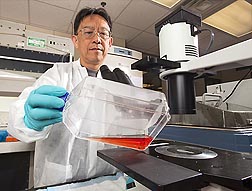A new procedure devised by U.S. Department of Agriculture (USDA) scientists to extract lunasin from soybean seeds could expedite further studies of this peptide for its cancer-fighting potential and other health benefits.
In addition to inhibiting certain cancerous cells in laboratory tests, lunasin has demonstrated anti-inflammatory activity that may prove helpful in the battle against some chronic diseases. Unfortunately, obtaining sufficient amounts of lunasin has been a costly, time-consuming and laborious affair. This, in turn, has impeded lunasin’s investigation in large-scale animal and human clinical trials, according to Hari Krishnan, a molecular biologist with USDA’s Agricultural Research Service (ARS), Plant Genetics Research Unit in Columbia, Missouri.
Now, however, Krishnan and ARS colleague Thomas Wang report their development of a fast new procedure for extracting lunasin in amounts suitable to conduct these trials. Using the new procedure, they produced 3.2 grams of a concentrated form of lunasin, along with two protease inhibitors, from 100 grams of soybean flour. The actual extraction is done with a 30 percent solution of ethanol, followed by centrifuging steps and the addition of calcium chloride to further purify the concentrate, explains Krishnan. Wang leads the agency’s Diet, Genomics, and Immunology Laboratory in Beltsville, Maryland.
The entire process takes less than 2 hours and yields far more lunasin and protease inhibitor concentrate than other methods that have been tried, including sophisticated chromatography procedures and live cultures of genetically modified yeast or bacteria. Besides being faster, the new method can also be easily scaled up to yield much larger amounts, Krishnan and Wang report in the January 2015 online version of Food Chemistry.
Test-tube experiments conducted by Wang demonstrated the extract’s biological activity, inhibiting the production of inflammation-causing cytokines by human leukemia cells derived from a line called THP-1, which is commonly used in biomedical research. Their investigations coincide with increased scientific attention on the preventive role that consuming soy or soy products can play in reducing breast, colon and other cancers.
Read more about this research in the July 2015 issue of AgResearch. ARS is USDA’s principal intramural scientific research agency.

